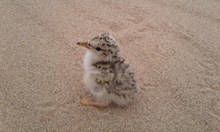21 December, 2022
Tern colony success at Forvie despite avian flu

Terns at NatureScot’s Forvie National Nature Reserve (NNRs) did well in 2022, despite the threat of avian flu.
In a year where the virus devastated many seabird colonies, including tern colonies in England, The Netherlands and France, staff at the north east reserve were delighted to see several species have a good season.
The breeding terns at Forvie are of international importance and each year the reserve is carefully managed with closed areas and fencing to help protect the birds from disturbance and predation.
This year at least 17 little tern chicks successfully fledged – the highest number since 2014. The species is on the edge in the UK as a whole, as a result of factors such as poor weather and predation.
Sandwich terns at the reserve had a good season with 1,031 pairs breeding and at least 865 young fledged. The breeding pairs represent around 10% of the entire UK breeding population so the colony is of national importance.
Meanwhile 1,140 pairs of Arctic terns bred with at least 882 chicks fledged, while 107 pairs of common tern produced 83 fledged young.
An all-time record was also recorded for black-headed gulls at Forvie, with at least 1,029 fledged young, while the kittiwake colony had 705 fledged young - a great result for a cliff-nesting seabird that has declined widely in Scotland in recent years.
Unfortunately it wasn’t all good news, however, with eiders at the reserve having a poor year. With around 100 nests recorded, only 21 young successfully fledged, with avian flu thought to be a likely cause of mortality.
NatureScot Reserve Officer Daryl Short said: “This year has undoubtedly been a difficult one, seeing the devastating impact of avian flu on birds around our coasts. Against that backdrop, it seems little short of a miracle that the terns at Forvie have had such a good season – a triumph in the face of adversity. It’s particularly pleasing that the little terns did so well, as the species has generally struggled here in recent years.
“Sadly, despite a good rate of hatching success, only a few eider ducklings survived to fledge. Anecdotal evidence suggests avian flu was a likely cause of mortality. Ducklings tend to feed and roost communally at extremely close quarters, so any contagious disease is a real danger to them at this stage.”
With the threat of the virus still very much with us heading into 2023, Scotland’s avian flu task force, led by NatureScot, is continuing to work flat out to gain a better understanding of the virus and take the necessary action on the ground to protect our wild birds.
A number of interesting wildlife sightings were recorded over the year, including a bee-eater in August that provided a splash of Mediterranean colour; a dusky warbler in November - just the fifth ever record for north-east Scotland; and the best September ‘fall’ (an en-masse arrival of small migrant birds like flycatchers, chats and warblers) since 2008.
The reserve also saw its first record of a chamomile shark moth, and it was a great year for the hummingbird hawk-moth, a migrant from southern Europe, with 10 records during late summer – doubtless assisted by the good weather at the time.
This year another 350 metres of footpath at the reserve has also been upgraded, while a full programme of public events in 2022 saw around 300 people attend activities including guided walks, illustrated talks and a family fun day.
NatureScot Chief Executive Francesca Osowska said: “This year has been a challenging one for nature in Scotland, as we saw an unprecedented avian flu outbreak that took a devastating toll on our wild birds, with NatureScot leading the national response to the crisis.
“As we look back on 2022, it’s heartening to hear some more hopeful stories from our National Nature Reserves and reflect on the great work staff are doing on the ground for nature and people.
“With new global targets for nature just agreed this week at the United Nations Biodiversity Conference (COP15), we head into 2023 with stronger than ever resolve to lead the bold action needed to protect, restore and value nature, and tackle the twin crises of climate change and biodiversity loss.”
ENDS
Contact information
- Name
- NatureScot Media
- Telephone
- 0131 316 2655
- media@nature.scot
Notes to editors
See our avian flu webpages for more information on the ongoing work of Scotland’s avian flu taskforce.
Find out more about our National Nature Reserves across Scotland.
NatureScot is Scotland's nature agency. We work to enhance our natural environment in Scotland and inspire everyone to care more about it. Our priority is a nature-rich future for Scotland and an effective response to the climate emergency. For more information, visit our website at www.nature.scot or follow us on X at https://x.com/NatureScot
’S e NatureScot buidheann nàdair na h-Alba. Bidh sinn a’ neartachadh àrainneachd na h-Alba agus a’ brosnachadh dhaoine gu barrachd suim a chur ann an nàdar. Tha e mar phrìomhachas againn gum bi nàdar na h-Alba beairteach agus gun dèilig sinn gu h-èifeachdach le èiginn na gnàth-shìde. Tha an tuilleadh fiosrachaidh aig www.nature.scot no air X aig https://x.com/NatureScot



